| Fee income at top accountancy firms is up by 21.5 per cent, and recruitment is set to grow by 7 per cent |
Back |
| The Irish accountancy sector continues to boom, fuelled by a buoyant economy, and increasing regulation. Fee income amongst the top twenty-two firms responding to this year's FINANCE Annual Accountancy Survey now totals €782 million, up 21.5 per cent, with fee income amongst the 'Big 4' up 18.4 per cent on last year. |
PricewaterhouseCoopers (PwC) has returned to the top of the heap in this year’s Annual FINANCE Accountancy Survey, overtaking KPMG to regain its crown as Ireland’s largest accountancy firm. Last year, in what was the first year that KPMG benefited from a full-year inclusion of the activities of Andersen, which it acquired in 2002, KPMG beat PwC to the top spot in terms of fee income by just €1 million.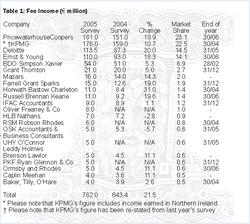 | | Table 1: Fee Income (€ million) |
Profitablity
This year however, the tables have turned, in what has been a prosperous year for the sector, with fee income overall of the 22 firms responding to this year’s survey totalling €782 million. This compares favourably with fee income of €643.4 in 2004, and when the four firms that did not respond to last year’s survey (RSM Robson Rhodes, Oliver Freaney, UHY O’Connor Leddy Holmes & Ryan Glennon) are removed from this year’s fee income total, it represents a total of €757 million, and a year-on-year growth of 19 per cent.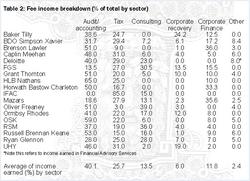 | | Table 2: Fee income breakdown (% of total by sector) |
With total fee income generated of €181 million over the past year up to June 30th, PwC is again the largest accountancy firm in Ireland, pipping KPMG by €5 million. Fee income soared at PwC over the past year, up from €151 million in 2004.
KPMG also posted a strong performance in the year to April 30th, with income up 10.7 per cent, from €159 million last year.
Elsewhere amongst the Big 4, Deloitte had the best year, with income up an impressive 30 per cent from €87 million in 2004, to €113 million in 2005. With these figures, Deloitte is now the third biggest accountancy firm in Ireland, overtaking Ernst & Young, who despite a strong year which saw its fee income grow by 18 per cent from €93 million in 2004 to €110 million in 2005, has fallen back to fourth place.
In the mid-tier firms, BDO Simpson Xavier under new managing partner Paul Keenan, is holding on firm to its fifth position, with fee income up 5.3 per cent to €54 million. Fee income at sixth placed Grant Thornton is also up 5 per cent to €21 million, while growth at Mazars and Farrell Grant Sparks (FGS) is very strong.
Mazars has grown by 14 per cent up to €16 million, while FGS is up 19.0 per cent to €15 million.
In joint ninth place are Horwath Bastow Charleton (HBC), who has leap-frogged IFAC Accountants in this year’s survey, and Russell Brennan Keane (RBK), both with fee income of €11 million. Strong growth of 31 per cent at HBC, has seen its fee income rise from €8.4 million in the 2004 survey. RBK also had a good year with growth of 19.6 per cent, however growth was stagnant at IFAC, with fee income remaining at the €9 million level.
Oliver Freaney & Co returns to the survey this year in twelfth place, with fee income of €8.4 million, followed by HLB Nathans with €7 million, indicating a fall-off of 2.8 per cent on its 2004 figure.
Other firms who have returned to the survey this year include RSM Robson Rhodes, who comes in in fourtheenth place with fee income of €6 million, UHY O’Connor Leddy Holmes, who has fee income of €5 million and is in joint fifteenth place, and PFK Ryan Glennon and Co, who also comes in joint fifteenth place. Sharing this spot are Brenson Lawler, OSK and Ormbsy & Rhodes.
Bringing up the rear are Caplin Meehan and Baker Tilly O’Hare, both of which recorded a fee income total of €4 million in 2005, indicating a growth of 11 per cent for Caplin Meehan, and 2.6 per cent for Baker Tilly O’Hare.
Fee income by sector
Of the 18 firms reporting a fee income breakdown by sector, the majority earn the most from audit and accounting, with the average of total income earned in audit and accounting standing at 40.1 per cent. Tax is the next biggest earner, with the average earned 25.7 per cent, followed by consulting at 13.5 per cent, and corporate finance at 11.9 per cent.
Some firms are very focused on particular areas, for example IFAC, which earns 85 per cent of its income from tax, and 15 per cent from consulting, and going against the trend, zero from audit and accounting.
The ‘efficiency factor’
In last year’s survey, the ‘efficiency factor’, ie income per staff member, was calculated for the first time, with Farrell Grant Sparks coming in at the top of the table with fee income of €127,300 generated for each of its 99 staff members.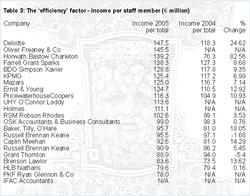 | | Table 3: The ‘efficiency’ factor - income per staff member (€ million) |
However, in this year’s survey, last year’s runner-up Deloitte has jumped to the top of the table, with fee income of €147,458 generated by each of its 767 staff members. This is not surprising when one considers that although Deloitte’s fee income grew by 30 per cent over the past year, its staff numbers only grew by 4 per cent.
Oliver Freaney & Co, who didn’t participate in last year’s survey, follows very closely behind Deloitte, with income of €145,455 for each of its 55 staff members.
Deloitte is the only ‘Big 4’ to make the top five most efficient firms, as Oliver Freaney is followed by Horwath Bastow Charleton, with income of €139,241 for each of its 79 staff. Last year’s winner Farrell Grant Sparks, whose income per partner of €138,318 for its 107 staff has grown since last year, is in fourth place, followed by BDO Simpson Xavier, with income of €128,777 for its 417 staff members.
When just chargeable staff are looked at, Oliver Freaney tops the table, with €173,913 in income generated by each of its 46 chargeable staff members. Deloitte improves on its performance in this section last year, by placing second, with income of €161,111 for its 702 chargeable staff members.
Also putting in a notable performance is E&Y, in fourth place with income of €154,062 for its 714 chargeable staff members.
A number of firms’ income per staff member has decreased over the past year, including Brenson Lawlor, whose 54 staff generated €88,889 this year, down from €93,958 in 2004. Also, Caplin Meehan saw a drop-off in its ‘efficiency factor’, with its 44 staff making €95,455 each, down from 97,081 in 2004.
When just chargeable staff are looked at, KPMG also suffers from a fall-off in its efficiency. This year, its 1,259 chargeable staff, of which 67 are partners, and 1,192 non-partner chargeable staff, contributed €139,793, down from the €142,346 generated by each staff member in 2004.
Staffing
According to the survey, the twenty-two top accountancy firms presently employ 6,349 people.
Last year, 5,814 people were employed in eighteen firms, and when the four who didn’t participate in last year’s survey (RSM Robson Rhodes, Ryan Glennon, UHY O’Connor Leddy Holmes, and Oliver Freaney) are removed, numbers employed have grown by 5.3 per cent to 6,137.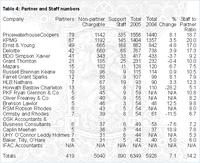 | | Table 4: Partner and Staff numbers |
There are now 419 partners in the industry, 5,040 non-partner chargeable staff, and 890 support staff.
As well as being the biggest firm by fee income, PwC is also the largest firm by staff numbers, employing 1556 people according to the survey. This represents an increase of 8 per cent on 2004, with most of the increase being on the support staff side, which jumped from 183 last year, to 335 this year.
As with fee income, KPMG is breathing down PwC’s neck with respect to employee figures, and it employs 1404 in total, an increase of 3.5 per cent on last year.
Although Deloitte has increased its fee income substantially, there hasn’t been a signficant increase in staff in the firm, with total employed standing at 767, just 4 per cent up on last year. E&Y has seen a similar increase, with growth of 4.8 over the past year, bringing its staff total up to 882.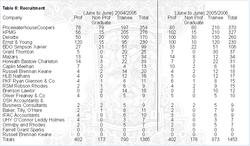 | | Table 6: Recruitment |
There was a fall-off in employees at a number of firms, with the most significant being at HBC, which reduced its staff from 110 last year to 79.
Other firms which saw a decline in the number of employees included Caplin Meehan, which now employs seven people less than last year, OSK, which has reduced its workforce by four, Ormbsy and Rhodes, which dropped by seven, and BDO, which is down by sixteen.
With regards to staff/partner ratio,KPMG has the highest number of staff per partner at a ratio of 20 (ie 20 staff per each partner). The largest employer, PwC, has a slightly lower ratio at 18.7, followed by Deloitte at 17.3 and E&Y at 17.0.
The lowest staff/partner ratio can be found at HBC, which has 5.1 staff members for each of its 13 partners.
Gender of partners
Almost 12 per cent of the 414 partners in the top Irish accountancy firms are female, according to this year’s survey which for the first time shows gender breakdown of all those at partner level in the top firms.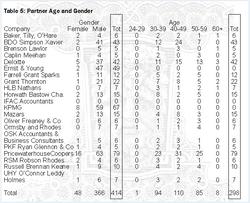 | | Table 5: Partner Age and Gender |
Female partners are in a huge minority, with just 48 in total, compared to 366 male partners in the industry. However, with more and more females choosing accountancy as a career, the proportion of female partners at the top firms is likely to continue to grow and grow.
Of the Big 4, PricewaterhouseCoopers has by far the highest proportion of female partners, with 20 per cent, or 16 out of its 79 partners female. Ernst & Young has the poorest representation of females, with just 4.1 per cent, or two or its 49 partners female.
Elsewhere, Baker Tilly, O’Hare and RSM Robson Rhodes have the highest proportion of females to males, with a third of the six partners at both firms female.
Age of partners
Just one partner in all the firms is under the age of 29, and this partner works in Ormsby Rhodes. Most partners, 110 out of the 298 for which ages are given, which represents 36 per cent of the total reported, fall into the 40-49 age group.
The next most popular age-group is 30-39, with 32 per cent (94 partners) of the total, followed by the 50-59 age group, which accounts for 28.6 (85 partners) of the total. There are just 8 partners in the 60+ category, representing just 3 per cent of the total reported, although if a recent recommendation that the statutory retirement age of 65 is removed, this category should grow in time!
Of the two Big 4 firms which reported an age break-down, the majority of both PricewaterhouseCoopers and Deloitte’s partners fall into the 40-49 age-group. Horwath Bastow Charleton has one of the youngest work forces, with eight of its 15 partners falling into the 30-39 category.
Salary trends
Salaries in the accountancy profession are expected to drop off slightly over the coming year, with the majority of those responding to this question, 55.6 per cent, giving an expected salary increase for general non-partner staff of between and 0-5 per cent for the coming year.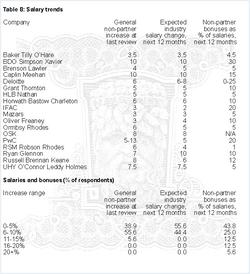 | | Table 8: Salary trends |
At last year’s salary review, the majority of employees, at 55.6 per cent, in the sector received increases of between 6-10 per cent.
Forty-four per cent of employees will receive a raise of between 6-10 per cent over the coming year, with none receiving anything higher than this. With regards to bonuses, there is a greater variety of figures given, with the majority receiving 0-5 per cent of their salary as a bonus, and 25 per cent receiving between 6-10 per cent. Approximately 6 per cent can expect to receive over 20 per cent of their salary as a bonus.
Within each company, the remuneration figures differ. The mid-tier and smaller firms lead the pack in terms of remuneration over the coming year, indicative perhaps of the argument outlined on page 7 regarding the skills shortage within the industry.
Three firms – BDO, Caplin Meehan and Ryan Glennon - intend giving increases of 10 per cent to their employees at the next salary review with BDO also topping the bonus league table, with predicted bonuses of 30 per cent of salary to be given in the next twelve months. Bonuses at PwC and IFAC will also be quite considerable next year, as they are expected to come in at 20 per cent.
Recruitment
With a staff shortage highlighted as the biggest problem for the industry going forward, it is no surprise that all firms are set to recruit heavily over the coming year. | | Table 7: Recruitment trends |
In total, 1,453 people will be recruited in the accountancy profession next year, up 7 per cent from the 1,365 recruited last year. Of these, 402 will be professionals, the same figure that were hired last year.
The number of non-professional graduates recruited is set to grow by five to 178, while the total trainees hired is expected to grow by 83.
The biggest recruiter will be PwC, who aims to increase its intake of 354 last year, to 370 over the coming year. This will see it take in what appears to be its highest ever number of trainees at 210.
KPMG will follow a similar path, and aims to increase its staff intake from 276 last year, to 327, with again another high for its trainee programme, with 210 planned trainees to be hired over the next year.
Elsewhere amongst the Big 4, both Deloitte and E&Y are also to recruit big numbers, Deloitte 260, up from 170 last year, while E&Y will again aim for 230, as it did last year. Again, most of these will be trainees, although Deloitte hopes to double its professional intake from 50 to 100.
BDO is looking to hire across the board to boost its employment figures by 106, 51 of which will be trainees.
Growth areas
Tax is driving growth in the sector, with over 43 per cent of firms responding to the question of ‘Which area had the strongest revenue growth over the past year?’, choosing tax. This is followed by audit and accounting with 25 per cent, and corporate finance, with 19 per cent.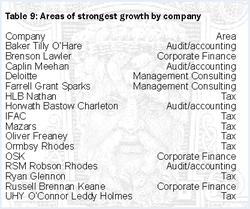 | | Table 9: Areas of strongest growth by company |
Last year, corporate finance, followed by tax, was identified as a key growth driver.
Tax was identified as the strongest revenue driver among firms such as IFAC, Mazars, Oliver Freaney, and Ryan Glennon, while Baker Tilly O’Hare, Caplin Meehan and HBC said it was audit and accounting.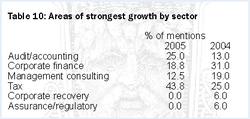 | | Table 10: Areas of strongest growth by sector |
|
Survey methodology
The FINANCE Accountancy Survey 2005 was carried out in September and October of this year.
Firms were asked to report fee income earned in the Republic of Ireland only. The survey was carried out amongst accountancy firms in Ireland who have fee income of more than one million, and more than four partners. However, some firms which were surveyed declined to participate. FINANCE does not seek to verify the date reported by each firm.
|
| Article appeared in the October 2005 issue.
|
|